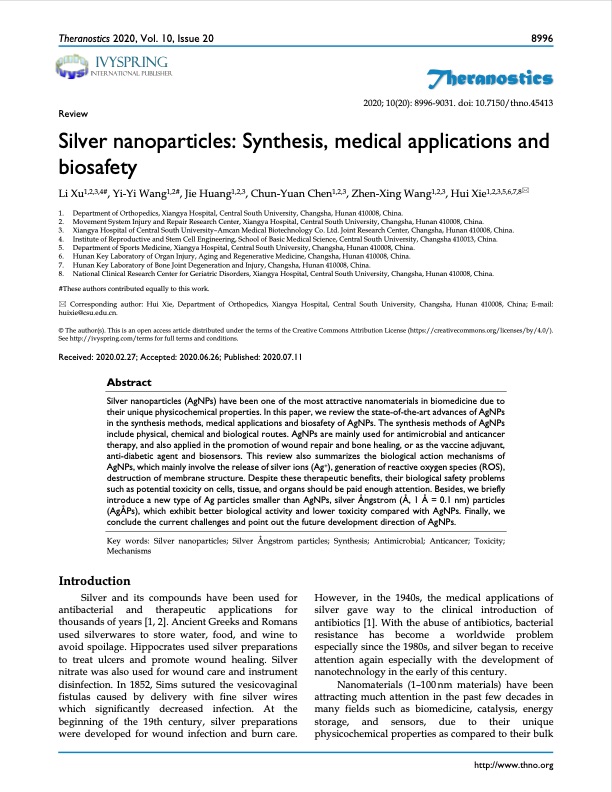
PDF Publication Title:
Text from PDF Page: 001
Theranostics 2020, Vol. 10, Issue 20 8996 Ivyspring International Publisher Review Theranostics Silver nanoparticles: Synthesis, medical applications and biosafety Li Xu1,2,3,4#, Yi-Yi Wang1,2#, Jie Huang1,2,3, Chun-Yuan Chen1,2,3, Zhen-Xing Wang1,2,3, Hui Xie1,2,3,5,6,7,8 1. Department of Orthopedics, Xiangya Hospital, Central South University, Changsha, Hunan 410008, China. 2. Movement System Injury and Repair Research Center, Xiangya Hospital, Central South University, Changsha, Hunan 410008, China. 3. Xiangya Hospital of Central South University–Amcan Medical Biotechnology Co. Ltd. Joint Research Center, Changsha, Hunan 410008, China. 4. Institute of Reproductive and Stem Cell Engineering, School of Basic Medical Science, Central South University, Changsha 410013, China. 5. Department of Sports Medicine, Xiangya Hospital, Central South University, Changsha, Hunan 410008, China. 6. Hunan Key Laboratory of Organ Injury, Aging and Regenerative Medicine, Changsha, Hunan 410008, China. 7. Hunan Key Laboratory of Bone Joint Degeneration and Injury, Changsha, Hunan 410008, China. 8. National Clinical Research Center for Geriatric Disorders, Xiangya Hospital, Central South University, Changsha, Hunan 410008, China. #These authors contributed equally to this work. Corresponding author: Hui Xie, Department of Orthopedics, Xiangya Hospital, Central South University, Changsha, Hunan 410008, China; E-mail: huixie@csu.edu.cn. © The author(s). This is an open access article distributed under the terms of the Creative Commons Attribution License (https://creativecommons.org/licenses/by/4.0/). See http://ivyspring.com/terms for full terms and conditions. Received: 2020.02.27; Accepted: 2020.06.26; Published: 2020.07.11 Abstract Silver nanoparticles (AgNPs) have been one of the most attractive nanomaterials in biomedicine due to their unique physicochemical properties. In this paper, we review the state-of-the-art advances of AgNPs in the synthesis methods, medical applications and biosafety of AgNPs. The synthesis methods of AgNPs include physical, chemical and biological routes. AgNPs are mainly used for antimicrobial and anticancer therapy, and also applied in the promotion of wound repair and bone healing, or as the vaccine adjuvant, anti-diabetic agent and biosensors. This review also summarizes the biological action mechanisms of AgNPs, which mainly involve the release of silver ions (Ag+), generation of reactive oxygen species (ROS), destruction of membrane structure. Despite these therapeutic benefits, their biological safety problems such as potential toxicity on cells, tissue, and organs should be paid enough attention. Besides, we briefly introduce a new type of Ag particles smaller than AgNPs, silver Ångstrom (Å, 1 Å = 0.1 nm) particles (AgÅPs), which exhibit better biological activity and lower toxicity compared with AgNPs. Finally, we conclude the current challenges and point out the future development direction of AgNPs. Key words: Silver nanoparticles; Silver Ångstrom particles; Synthesis; Antimicrobial; Anticancer; Toxicity; Mechanisms 2020; 10(20): 8996-9031. doi: 10.7150/thno.45413 Introduction Silver and its compounds have been used for antibacterial and therapeutic applications for thousands of years [1, 2]. Ancient Greeks and Romans used silverwares to store water, food, and wine to avoid spoilage. Hippocrates used silver preparations to treat ulcers and promote wound healing. Silver nitrate was also used for wound care and instrument disinfection. In 1852, Sims sutured the vesicovaginal fistulas caused by delivery with fine silver wires which significantly decreased infection. At the beginning of the 19th century, silver preparations were developed for wound infection and burn care. However, in the 1940s, the medical applications of silver gave way to the clinical introduction of antibiotics [1]. With the abuse of antibiotics, bacterial resistance has become a worldwide problem especially since the 1980s, and silver began to receive attention again especially with the development of nanotechnology in the early of this century. Nanomaterials (1–100 nm materials) have been attracting much attention in the past few decades in many fields such as biomedicine, catalysis, energy storage, and sensors, due to their unique physicochemical properties as compared to their bulk http://www.thno.orgPDF Image | Silver nanoparticles Synthesis medical applications safety

PDF Search Title:
Silver nanoparticles Synthesis medical applications safetyOriginal File Name Searched:
thnov10p8996.pdfDIY PDF Search: Google It | Yahoo | Bing
Turbine and System Plans CAD CAM: Special for this month, any plans are $10,000 for complete Cad/Cam blueprints. License is for one build. Try before you buy a production license. More Info
Waste Heat Power Technology: Organic Rankine Cycle uses waste heat to make electricity, shaft horsepower and cooling. More Info
All Turbine and System Products: Infinity Turbine ORD systems, turbine generator sets, build plans and more to use your waste heat from 30C to 100C. More Info
CO2 Phase Change Demonstrator: CO2 goes supercritical at 30 C. This is a experimental platform which you can use to demonstrate phase change with low heat. Includes integration area for small CO2 turbine, static generator, and more. This can also be used for a GTL Gas to Liquids experimental platform. More Info
Introducing the Infinity Turbine Products Infinity Turbine develops and builds systems for making power from waste heat. It also is working on innovative strategies for storing, making, and deploying energy. More Info
Need Strategy? Use our Consulting and analyst services Infinity Turbine LLC is pleased to announce its consulting and analyst services. We have worked in the renewable energy industry as a researcher, developing sales and markets, along with may inventions and innovations. More Info
Made in USA with Global Energy Millennial Web Engine These pages were made with the Global Energy Web PDF Engine using Filemaker (Claris) software.
Infinity Turbine Developing Spinning Disc Reactor SDR or Spinning Disc Reactors reduce processing time for liquid production of Silver Nanoparticles.
| CONTACT TEL: 608-238-6001 Email: greg@infinityturbine.com | RSS | AMP |